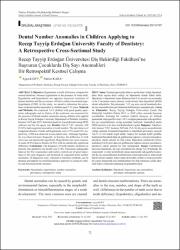| dc.contributor.author | Kurt, Ayça | |
| dc.contributor.author | Kara, Pakize | |
| dc.date.accessioned | 2023-03-01T07:03:19Z | |
| dc.date.available | 2023-03-01T07:03:19Z | |
| dc.date.issued | 2022 | en_US |
| dc.identifier.citation | Kurt, A. & Kara, P. (2022). Dental number anomalies in children applying to Recep Tayyip Erdoğan University Faculty of Dentistry: A retrospective cross-sectional study. Türkiye Klinikleri Diş Hekimliği Bilimleri Dergisi, 28(19, 72-78. http://doi.org/10.5336/dentalsci.2021-81197 | en_US |
| dc.identifier.issn | 2146-8966 | |
| dc.identifier.uri | http://doi.org/10.5336/dentalsci.2021-81197 | |
| dc.identifier.uri | https://hdl.handle.net/11436/7730 | |
| dc.description.abstract | Objective: Hypodontia is tooth deficiency compared to
normal dentition, whereas hyperdontia is the presence of extra teeth.
Hypodontia and hyperdontia are opposite numerical variations of
human dentition and the occurrence of both is called concomitant hypohyperdontia (CHH). In this study, we aimed to determine the prevalence of dental number anomalies in children aged 7-12 years. Material
and Methods: We examined 7,011 children with good quality panoramic radiographs and no history of the syndrome was examined for
the presence of dental number anomalies among children who applied
to Recep Tayyip Erdoğan University Department of Pediatric Dentistry
between 2015 and 2019. Statistical analysis was performed using SPSS
software and the chi-square test. Results: Out of 7,011 patients, 360
(5.14%) had congenital anomalies in tooth number. The prevalences of
congenital absence of teeth and hyperdontia were 4.75% and 0.4%, respectively. CHH was observed in one patient only. Although hypodontia was observed more frequently in females, the difference in both
sexes was not statistically significant. Hyperdontia was more common
in males (8.6%) than in females (6.9%), with no statistically significant
difference. Conclusion: The frequency of tooth number anomalies in
patients who applied to our faculty was 5.14%. Panoramic radiographs
taken at the first examination and routine controls are of great importance in the early diagnosis and treatment of congenital tooth number
anomalies. If diagnosed early, alternative treatment methods can be
planned and applied in a multidisciplinary approach to create an esthetic and functional tooth structure. | en_US |
| dc.description.abstract | Amaç: Normal yapı içinde daha az sayıda dişin varlığı hipodonti,
daha fazla sayıda dişin varlığı ise hiperdonti olarak kabul edilir.
Hipodonti ve hiperdonti, insan dişlenmesinin 2 zıt sayısal varyasyonudur
ve bu 2 durumun ortaya çıkması, konkomitant hipo-hiperdonti (KHH)
olarak adlandırılır. Bu çalışmada, 7-12 yaş arası çocuk hastalarda dental sayı anomalilerinin prevalansının belirlenmesi amaçlanmıştır. Gereç
ve Yöntemler: Recep Tayyip Erdoğan Üniversitesi Çocuk Diş
Hekimliği Anabilim Dalına 2015 ve 2019 yılları arasında başvuran
çocuklardan, herhangi bir sendrom öyküsü olmayan, iyi kalitede
panoramik radyografları olan 7.011 çocuğun panoramik radyografileri,
diş sayı anomalilerinin varlığı açısından incelendi. İstatistiksel analiz
SPSS yazılımı ve ki-kare testi kullanılarak yapıldı. Bulgular: Fakültemizde taranan 7.011 hastanın 360’ında (%5,14) diş sayısı anomalilerinin
varlığı saptandı. Konjenital hipodonti ve hiperdonti prevalansı sırasıyla
%4,75 ve 0,4 olarak tespit edildi. Sadece bir hastada KHH görüldü.
Kadınlarda hipodonti daha sık görülmesine rağmen, 2 cinsiyet arasında istatistiksel olarak anlamlı bir fark yoktu. Hiperdonti erkeklerde (%8,6),
kadınlara (%6,9) göre daha sık görülmesine rağmen cinsiyet açısından istatistiksel olarak anlamlı bir fark bulunamadı. Sonuç: Fakültemize
başvuran hastalarda, diş sayı anomalilerinin sıklığı %5,14 bulundu. İlk
muayenede ve rutin kontrollerde alınan panoramik radyograflar konjenital diş sayı anomalilerinin eksikliklerinin erken teşhisinde ve tedavisinde
büyük öneme sahiptir. Erken teşhis ile birlikte, estetik ve fonksiyonel bir
diş yapısı oluşturmak için multidisipliner bir ekip yaklaşımı içinde alternatif tedavi yöntemleri planlanıp uygulanabilecektir. | en_US |
| dc.language.iso | eng | en_US |
| dc.publisher | Türkiye Klinikleri Yayınevi | en_US |
| dc.rights | info:eu-repo/semantics/openAccess | en_US |
| dc.subject | Hypodontia | en_US |
| dc.subject | Hyperdontia | en_US |
| dc.subject | Number anomalies | en_US |
| dc.subject | Prevalence | en_US |
| dc.subject | Retrospective study | en_US |
| dc.subject | Hipodonti | en_US |
| dc.subject | Hiperdonti | en_US |
| dc.subject | Sayı anomalileri | en_US |
| dc.subject | Prevalans | en_US |
| dc.subject | Retrospektif çalışma | en_US |
| dc.title | Dental number anomalies in children applying to Recep Tayyip Erdoğan University Faculty of Dentistry: A retrospective cross-sectional study | en_US |
| dc.title.alternative | Recep Tayyip Erdoğan Üniversitesi Diş Hekimliği Fakültesi’ne başvuran çocuklarda diş sayı anomalileri: Bir retrospektif kesitsel çalışma | en_US |
| dc.type | article | en_US |
| dc.contributor.department | RTEÜ, Diş Hekimliği Fakültesi, Klinik Bilimler Bölümü | en_US |
| dc.contributor.institutionauthor | Kurt, Ayça | |
| dc.contributor.institutionauthor | Kara, Pakize | |
| dc.identifier.doi | 10.5336/dentalsci.2021-81197 | en_US |
| dc.identifier.volume | 28 | en_US |
| dc.identifier.issue | 1 | en_US |
| dc.identifier.startpage | 72 | en_US |
| dc.identifier.endpage | 78 | en_US |
| dc.relation.journal | Türkiye Klinikleri Diş Hekimliği Bilimleri Dergisi | en_US |
| dc.relation.publicationcategory | Makale - Uluslararası Hakemli Dergi - Kurum Öğretim Elemanı | en_US |


















